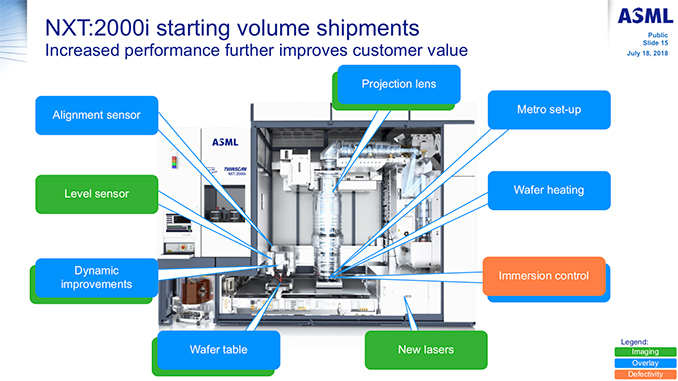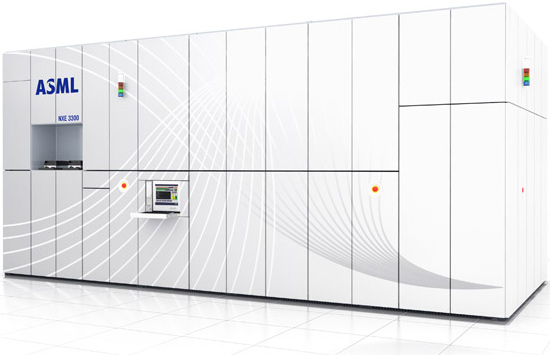ASML Ships Twinscan NXT:2000i Scanner for 7nm and 5nm DUV
by Anton Shilov on August 2, 2018 1:00 PM EST- Posted in
- Semiconductors
- EUV
- ASML
- DUV
- Twinscan NXT

ASML, the company known for producing equipment for the manufacture of processors and semiconductors at foundries, has started to ship its new Twinscan NXT:2000i DUV (Deep Ultra Violet) scanner that matches overlay performance of the company’s Twinscan NXE:3400B EUV (Extreme Ultra Violet) scanner. The new machine will be used to make chips using 5 nm and 7 nm nodes and will be required by makers of semiconductors who will have tighter overlay requirements and will have to mix-and-match overlay capabilities between different types of step-and-scan systems.
When leading manufacturers of chips start to use Twinscan NXE EUV lithography scanners for their 7 nm and more advanced process technologies in the coming quarters/years for some of the metal layers for the processors, DUV equipment is still required for other layers (for example, GlobalFoundries first version of 7nm is DUV only). Different makers of semiconductors will have their own specific requirements for their 7 nm and 5 nm process technologies particularly when it comes to on-product as well as mix-and-match overlay capabilities.

An example setup of a TwinScan NXE:3300-series EUV machine. It's quite big
Being a producer of step-and-scan systems, ASML develops equipment with generic requirements in mind: for a 7 nm node there is an on-product overlay requirement of 3.5 nm, so scanners have to support an overlay budget of 2.5 nm. Such requirements are achievable on ASML’s Twinscan NXE:3350B as well as the NXT:1980D tools. For 5 nm nodes overlay requirements will be tighter: ASML says that it is working with an on-product overlay requirement of 2.4 nm, which means that its scanners will have to feature an overlay budget of 1.9 nm. This numbers have been achieved by the NXE:3400B as well as the NXT:2000i machines.
Not all makers will need to match overlay accuracy across different step-and-scan systems, but those who will are going to need the new Twinscan NXT:2000i DUV scanners to work with the NXE:3400B EUV tools. The new systems do not necessarily offer a higher wafer throughput when compared to the NXT:1980D, but feature “several hardware innovations that will enable on-product overlay of 2.5 nm in mix-and-match use with EUV for the 7 and 5 nanometer logic nodes.”
ASML started volume shipments of its new Twinscan NXT:2000i step-and-scan systems last quarter and will ramp up production of the new tools in the coming years. Traditionally, the company does not disclose MSRPs of its equipment as final prices depend on multiple factors, including volumes.
Related Reading
- Samsung Foundry Roadmap: EUV-Based 7LPP for 2018, 3 nm Incoming
- Arm and Samsung Extend Artisan POP IP Collaboration to 7LPP and 5LPE Nodes
- The Future of Silicon: An Exclusive Interview with Dr. Gary Patton, CTO of GlobalFoundries
- EUV Lithography Makes Good Progress, Still Not Ready for Prime Time
- GlobalFoundries Gives 7 nm Capacity Update, Mulls Skipping 5 nm
Source: ASML










15 Comments
View All Comments
Incolumis - Thursday, August 2, 2018 - link
I'm proud to have worked on the machine👍🏻Notmyusualid - Thursday, August 2, 2018 - link
Lucky you, I bet it was (is?) fascinating work.Like me, I bet you lose your friends interest in the pub as you start to answer questions on what it is you really do... which leaves me thinking why'd you ask in the first place?
Incolumis - Friday, August 3, 2018 - link
Yes it is very interesting, and really difficult to understand. I build the part of the machine that measures the position of the chuck and houses the big lens. I don't even understand all the other submodules haha.I normally just say i work as a mechanic at ASML, people stop asking further, they alreay know it's above their understanding :)
justaviking - Thursday, August 2, 2018 - link
A dreadful lack of RGB LEDs.I'm not buying one.
BurntMyBacon - Tuesday, August 7, 2018 - link
Why would they need RGB LEDs to burn out your retinas? They have EUV lighting for that. (o_o)psychobriggsy - Tuesday, October 23, 2018 - link
Hah, let's not give Corsair any ideas here! They haven't even got DUV case LEDs yet :pFullmetalTitan - Thursday, August 2, 2018 - link
No final costs, but I am curious how much more that improved overlay budget costs. $5M? $50M?stanleyipkiss - Thursday, August 2, 2018 - link
Can I lease one? $300 monthly is best I can do.eastcoast_pete - Thursday, August 2, 2018 - link
This announcement by ASML of volume shipment of their NXT:2000i DUV scanner is, at least to me, the most concrete evidence that we will indeed see significant shipments of several 7 nm chips by 2019 at least from TSMC, Samsung and GloFo. ASML's EUV scanner is quite something to behold and (theoretically) capable of 5 nm and even lower, but my understanding is that yield of 5 nm still leaves much to be desired (that's the fabs problem, not ASML's , their EUV scanner works). One big question we are all left to wonder is: Intel - what's happening, and what's keeping you?SquarePeg - Friday, August 3, 2018 - link
I'm wondering if Intel will have it's 10nm ready for 2019 like they are now saying. It would be a massive blow if Intel had to delay into 2020 for any reason. I also wonder if going forward they will move away from their strategy of BIG monolithic node shrinks to something similar to what Samsung does with a yearly half node process improvement.